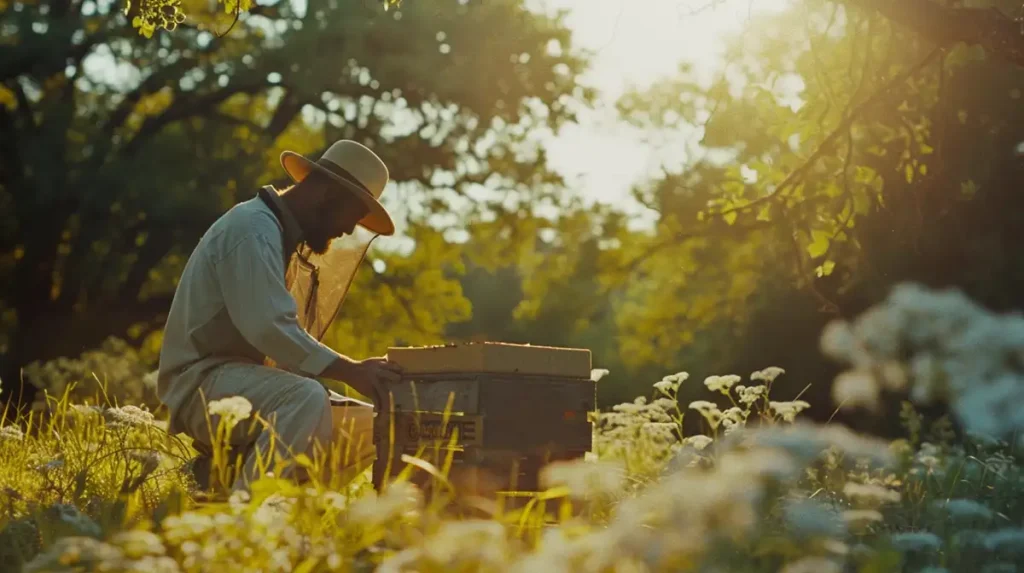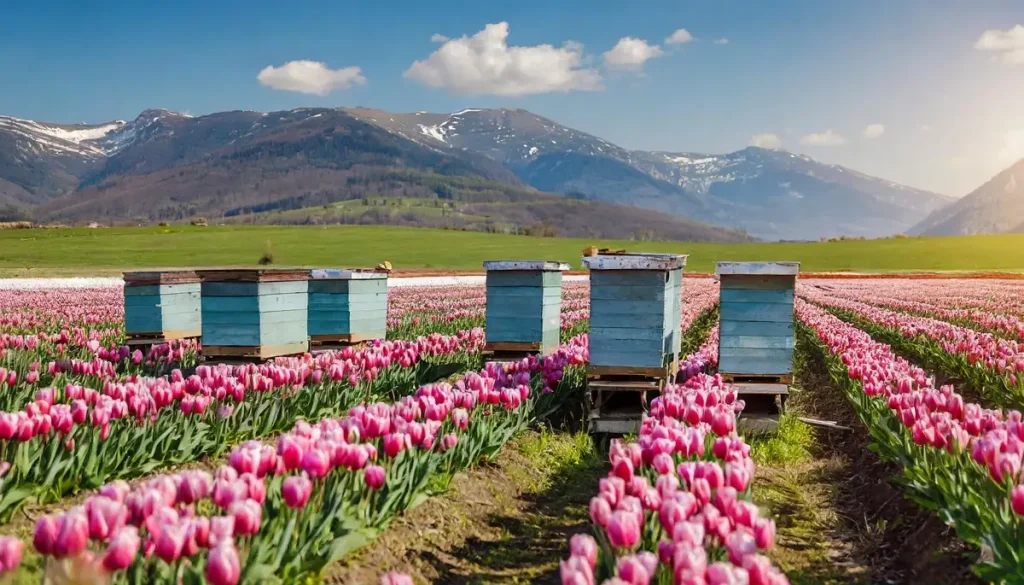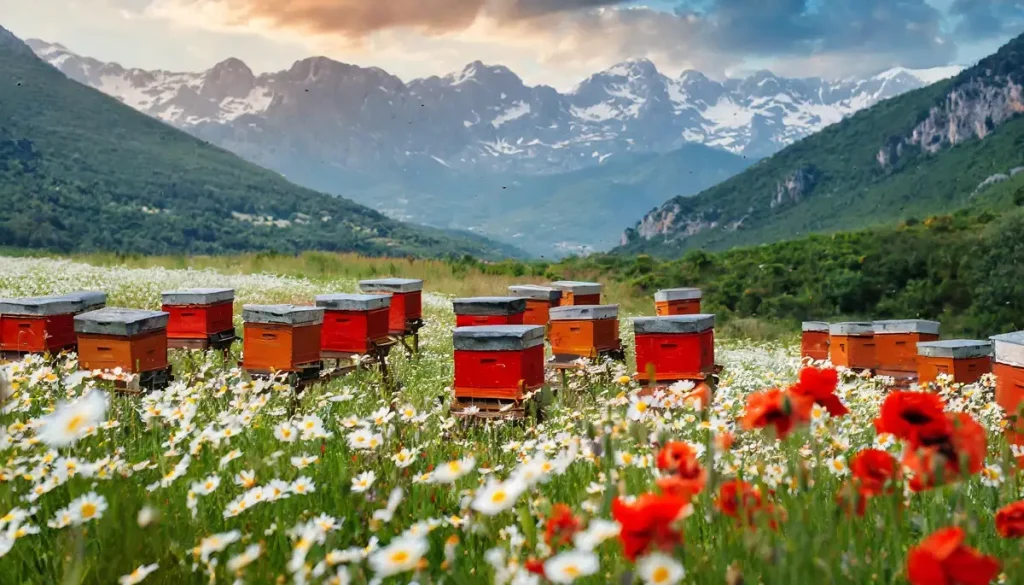Table of Contents
Anyone planning to take up the beekeeping hobby must carefully consider where to locate beekeeping hives. After all, without successful hives there will be no beekeeping to speak of. Where and how you place your hives makes all the difference in the world.
This post discusses eight important things to consider when placing hives. Note that the information here is introductory in nature. Each of the listed points can be influenced by a range of factors including average climate, local geography, urban versus suburban environments, the number of hives being established, and so forth.
Also note that there may be some regional differences based on geographic location. For example, when I talk about positioning beehives toward the southeast in order to take advantage of morning sun, that applies to countries in the northern hemisphere. In the southern hemisphere, you would want to position beehives to the northeast for that same morning sun.
Be sure to take advantage of as many online and local resources as you can find. There is plenty of great information out there if you are willing to look. The more you know about hives and beekeeping, the more successful your endeavor will be. So without further ado, here are the eight considerations when looking to locate beehives.

1. Sun and Shade
There are two things to think about in this regard. First is the idea of morning sun as mentioned above. Bees are genetically programmed to respond to sun first thing in the morning. The sun is essentially their alarm clock. Placing hives facing the southeast exposes them to the maximum amount of morning sunlight, thus encouraging the bees to get up and get going. Again, think northeast in southern hemisphere countries.
The second thing to consider is the amount of sun your property gets throughout the course of the day. If you live in a climate well away from the equator, which is to say you do not get extremely hot temperatures for extended amounts of time, it’s fine to locate hives in an area where they will be exposed to sunlight most of the day.
A couple of good examples here are Canada and the UK. Both countries are not likely to see extended periods of high heat (although there are exceptions – just think summer of 2018 for extended hot weather in both locations). On days when things do get extremely warm, temperatures are not likely to be so warm as to harm the bees. Hives can be placed in locations that allow for moderate sunlight throughout the day.
On the other hand, a beekeeper in Mexico is much closer to the equator. The sun can be very intense in that part of the world, as can temperatures. So it’s best for beekeepers to locate hives in areas that will get at least some shade during the high heat of the afternoon hours.
2. Wind Exposure
Wind can be stressful to bees whether they exist in the wild or live in your hives. That’s why bees in the wild tend to construct their hives in places where natural windbreaks exist. Do your bees a favor and follow their example. Locate hives where natural windbreaks exist. If no such areas exist on your property, you may need to construct artificial windbreaks.
Near a tree line is an excellent location for beehives. The trees provide a natural windbreak and an area for the bees to forage during the day. Another option is in front of or behind a hedgerow. Hedges do much the same thing as trees. In the absence of vegetation, locating hives near an out building is another option.
Here is what you’re trying to avoid: wind driving moisture into your hives or blowing the tops off. Both conditions are extremely stressful to bees. Moisture can be especially troubling because bees will have to work extra hard to deal with it. That means they will be putting less effort into producing honey.
If you have found a good windbreak for your hives yet you still discover that tops are blowing off, you can always weigh the tops down with bricks or rocks. During especially severe weather, you might have to strap the hives closed.
- Carter, Anthony (Author)
- English (Publication Language)
- 194 Pages - 02/28/2024 (Publication Date) - Independently published (Publisher)
3. Ground Height
Though honeybees have been known to build nests in the ground, they tend to stay away from direct contact with soil due to dampness. Moisture and beehives do not get along all that well. As such, ground height is a consideration. This suggests, first and foremost, that you don’t place hives directly on the ground. Find a way to elevate them.
If you are not really sure that moisture is a problem, think about what could happen if it were allowed to pool around the base of a hive. Moisture causes two problems for bees. First, it makes it more difficult for them to produce honey. A lot more work goes into honey production when moisture levels are too high.
More importantly, excess moisture is an open door to mold and mildew. That’s not good. Whether you know it or not, mold and mildew can make your bees sick. It can increase their susceptibility to certain diseases that are normally not a problem in dry conditions.
As for elevating your hives, stacking them on pallets or creating a platform using cinder blocks and plywood is normally sufficient. Cinder blocks alone work well too. The idea is to get the hives at least a foot or two off the ground. Do not set them too high though, otherwise you may have trouble accessing the top one or two layers.
4. Water Access
Bees are like any other living creature inasmuch as they need water to survive. Yes, bees do drink water. They also carry water into the hive for larvae. Therefore, access to a natural supply of water is beneficial for your hives. Hopefully you have a pond, creek, or stream within a short distance. If you cannot locate the hives somewhere close to a natural water source, there are alternatives.
You can buy an inexpensive birdbath and keep it filled with water during the season. You just have to be careful to pay attention to the presence of mosquitoes. Another option is to fill a shallow tray with gravel and water. Place the tray somewhere close to the hives.
Regardless of your water source, it needs to be located somewhere within the normal flight pattern of the bees. Let’s say you position your hives just on the front side of a natural tree line. Observation tells you that the bees constantly fly in and out of the trees, so position your water feature somewhere between the tree line and the hives.

5. Level Ground
It is best to locate beehives on level ground. Why? Because it’s imperative that the hives be level from side to side but tilted slightly to the rear. This allows precipitation to roll off the top rather than soaking into the hive. If the ground is not level, you are going to have a harder time getting this combination just right.
6. Foot Traffic
Honeybees are largely harmless and docile creatures. However, they are known to perceive both humans and animals as threats if foot traffic in front of hive entrances is persistent. You have two options in this particular arena.
First, if you can find a location that is mostly free from foot traffic and still provides for the other things discussed in this article, locate your hives there. The less foot traffic the better. If you can’t avoid foot traffic, it is important that you position the hives so that the entrances face away from that traffic.
Bees are not likely to be bothered by humans or animals walking behind hives except under extraordinary circumstances. As long as they don’t perceive a threat to hive entrances, they should be fine.
7. Hive Spacing
Choose a location that has enough room to allow you to put ample space between the hives. You want to be able to walk fully around each hive in order to access it without bothering other hives. If hives are too close, servicing one could agitate the bees in the neighboring hive, and that’s something you don’t want.
There is a bit of comfort involved here as well. If you are straining yourself because hives are too close, you might eventually get frustrated under the misconception that beekeeping is far too much work. Why run that risk? Put enough space between your hives and you should find your work a lot more comfortable.
8. Staying Away from Neighbors
The final consideration is especially important in urban and suburban environments where neighbors could be close by. It is best to avoid placing hives where neighbors can come into close contact with them. There are several reasons for this.
First, you never know how neighbors are going to react to beehives. There are some people who just have a natural fear of bees even though honeybees are mostly harmless. Setting hives too close to a neighbor’s property line could cause unnecessary stress and angst. It could damage an otherwise good relationship you have with your neighbors.
Next, you have to assume your neighbors don’t know anything about beekeeping. They may not know enough to stay away from hive entrances or steer clear of flight zones. It only takes one misstep to cause a problem between your neighbors and your bees.
Finally, there may be ordinances where you live pertaining to how close beehives can be to neighboring property lines. Keeping your hives away from your neighbors’ property should alleviate most of these concerns. For your own protection though, it is wise to check into local ordinances before you locate your hives.
Where to Place a Beehive – Tying It All Together
I have given you eight things to consider when locating beehives. If you find it too overwhelming to try to think of all of them at once, I have a tip for you: create a scorecard. For every item on this list, mark it either yes or no in terms of whether requirements are met or not.
For example, put a ‘1’ in the ‘yes’ column if you have a location that offers ample morning sunshine. Then evaluate that site for the remaining seven factors. Put a ‘1’ in either the ‘yes’ or ‘no’ column for each item.
If your total combined ‘yes’ score is between 0 and 3, that location is probably not a good one. Scores between 4 and 6 suggest the location is okay, but you could probably do better. A score of 7 or better indicates you have found a good location for your hives.
Now you know the basics of locating beehives, it’s time to get out there and survey your property. Do your best to find locations that meet all the criteria on my list.
Looking to up your beekeeping game? Check out our latest product recommendations so you can take things to the next level!
Introducing The Top 12 Best Beekeeping Veils For 2024
Introducing The Top 20 Best Beekeeping Gloves For 2024
Introducing The Absolute Best Beekeeping Suits For 2024
The 15 Top Beekeeping Books for 2024
The Top 11 Honey Extractors for 2024
The Top 12 Mason Bee Houses for 2024
Beekeeping Disclaimer:
Beekeeping, like any agricultural activity, involves inherent risks. It is important to understand these risks and take appropriate measures to mitigate them.
Potential risks associated with beekeeping include:
- Bee stings: Honey bees are generally not aggressive but can become defensive if they feel threatened or their hive is disturbed. Bee stings can cause allergic reactions or even anaphylaxis in some individuals, which can be life-threatening. It is important to wear protective clothing and follow best practices when handling bees to minimize the risk of stings.
- Diseases and pests: Bees can be vulnerable to various diseases and pests, including mites, viruses, and bacterial infections. These can have significant impacts on bee colonies, leading to reduced honey production or even colony collapse. It is important to monitor hives regularly and take appropriate measures to prevent and treat diseases and pests.
- Weather conditions: Extreme weather conditions, such as drought or cold temperatures, can affect the health and productivity of bee colonies. It is important to ensure that hives are appropriately sheltered and provided with adequate food and water.
- Environmental hazards: Bees can be affected by environmental hazards such as pesticide exposure, pollution, and habitat loss. It is important to be aware of these hazards and take appropriate measures to protect bee colonies and promote healthy environments for bees.
- Legal requirements: Beekeeping may be subject to local, state, or national regulations, such as registration or inspection requirements. It is important to be aware of these requirements and comply with them.
While beekeeping can be a rewarding and enjoyable activity, it is important to be aware of the potential risks and take appropriate measures to mitigate them. By following best practices and staying informed about the latest developments in beekeeping, beekeepers can help ensure the health and productivity of their hives and contribute to the well-being of bee populations worldwide.
Last update on 2024-04-25 / Affiliate links / Images from Amazon Product Advertising API


